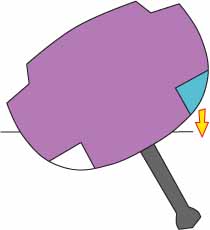
A common type of ballast for small boats that avoids many of the problems of high density ballast is water ballast. While it seems counter-intuitive that placing water in the hull (which is, after all, the same density as the water outside the hull) would add any stability, adding water ballast below the vertical center of gravity increases stability. The water ballast does not need to be lifted above the waterline to affect stability, as any material having greater bulk density than air will have an effect on the centre of gravity. It is the relationship between centre of gravity and centre of buoyancy that dictates the righting moment.
The advantage of water ballast is that the tanks can be emptied, reducing draft or the weight of the boat (e.g. for transport on ground) and water added back in (in small boats, simply by opening up the valves and letting the water flow in) after the boat is launched or cargo unloaded. Pumps can also be used to empty the leeward ballast tank and fill the windward tank as the boat tacks, and the quantity of ballast can be varied to keep the boat at the optimum angle of heel. On empty cargo vessels water is added to ballast tanks to increase propeller immersion, to improve steering, and to control trim and draft.
A disadvantage of water ballast is that water is not very dense and therefore the tanks required take up more space than other forms of ballast. Some manufacturers offer flexible ballast bags that are mounted outboard of the hull on both sides, and pumps that use the boat's speed through the water for power. When under way, the pump can be used to fill the windward side, while the lee side is allowed to drain. This system, while not very attractive, does allow significant gains in righting force with no modifications to the hull.
A trick commonly used on boats with water ballast is to link port and starboard tanks with a valved pipe. When preparing to tack, the valve is opened, and water in the windward tank, which is higher, is allowed to flow to the lee side, and the sheet is let off to keep the boat from heeling too far. Once as much water as possible has been transferred to the lee side, the boat is brought about and the sail sheeted in, lifting the newly full windward tank. A simple hand pump can then be used to move any remaining water from the lee to the windward tank.
(References: www. wikipedia.org)

No comments:
Post a Comment
Your comments are welcome!